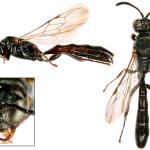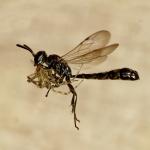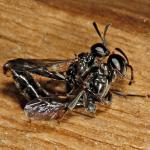A small, black, very thin solitary wasp, with a reddish mark on the fore leg. Identification keys are given in Yeo & Corbet (1995), Lomholdt (1984) and Richards (1980).
A widely distributed species in England and Wales, extending as far north as Yorkshire.
Also recorded from Ireland and the Channel Islands.
This species is not regarded as being scarce or threatened.
Has been recorded from a variety of habitats including woodland, parkland, gravel pits, sandy sites, chalk grassland and heathland.
On the wing from late May until early September.
Lomholdt (1984) states that nest burrows are stocked with small spiders such as Epeira, Linyphia or Tetragnatha. [‘Epeira’ is a very old name for Araneus and a wide range of other araneid genera. Adult examples of all these species are likely to be too large for Trypoxylon to tackle, and immatures are considered impossible to identify to species or, in most cases, even to genera (P Harvey, pers. comm.)].
Nests are constructed in old insect burrows or galleries in dry wood or hollow plant stems. Cells are separated with mud partitions.
No data available.
None recorded from Britain. In Europe, known parasites are the chrysidid wasp Pseudomalus [as Omalus] pusillus (Fabricius), the sarcophagid fly Amobia [as Pachyophthalmus] signata (Meigen) and the ichneumon Ephialtes manifestator (Linnaeus) (Lomholdt, 1984).
2012




